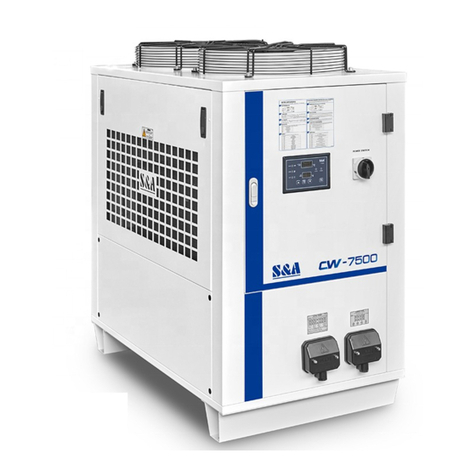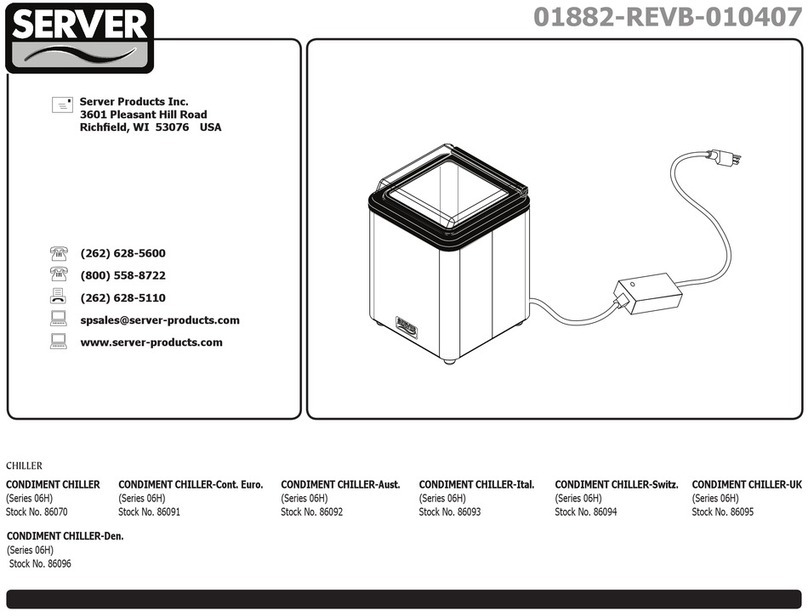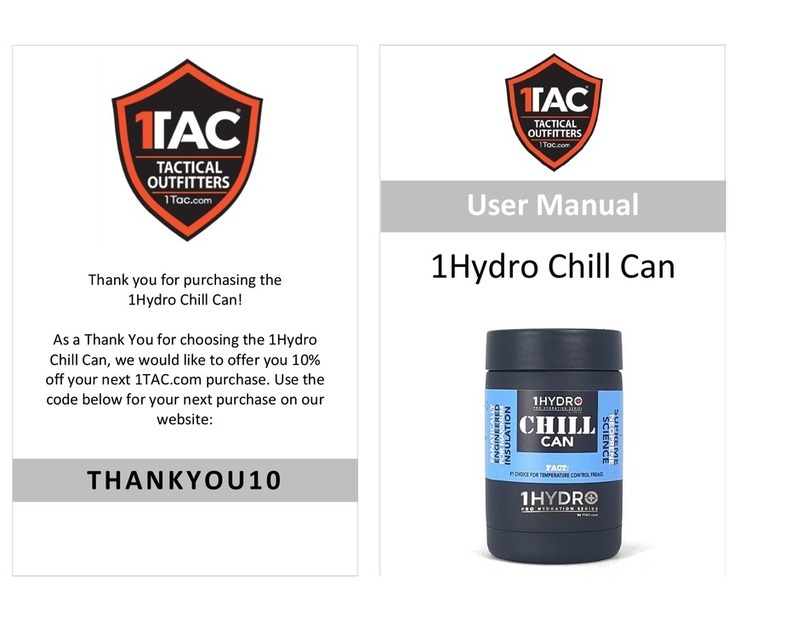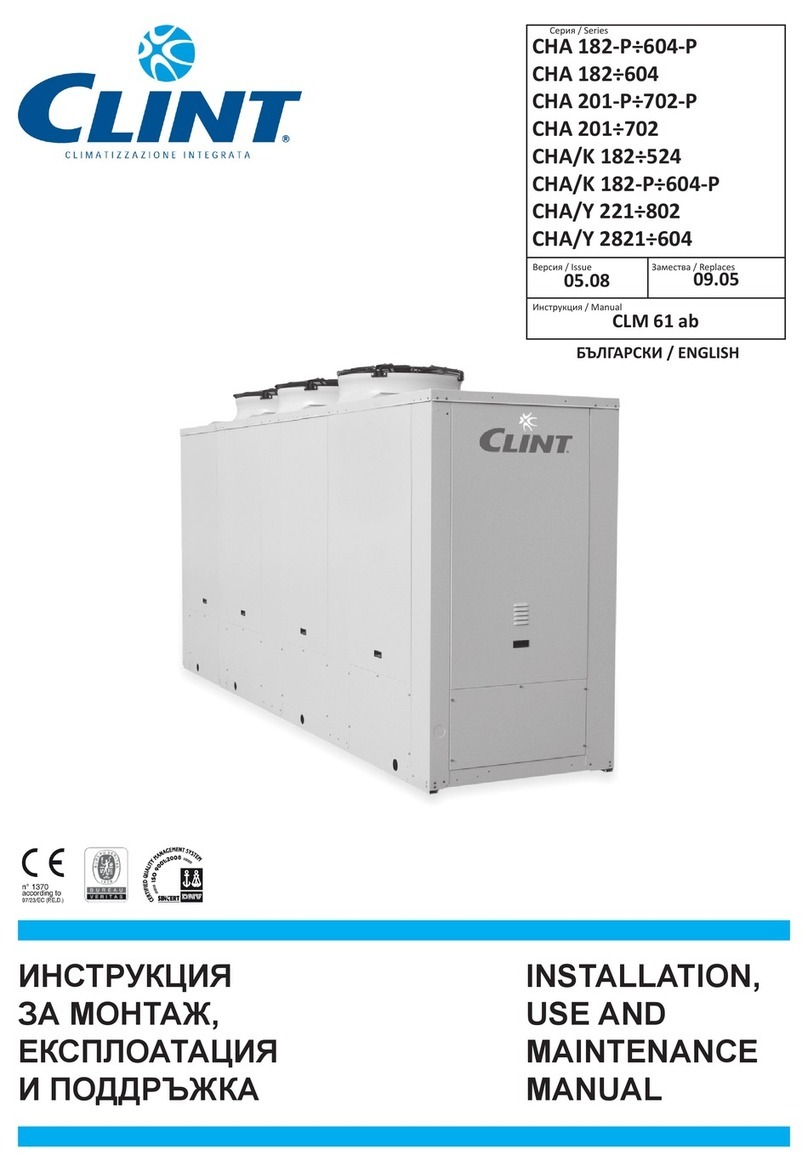Envicool EMW90HDNC1A User manual

EMW90HDNC1A Air-cooled Chiller
EMW90HDNC1A 风冷式冷水机组
User Manual
用户手册
深圳市英维克科技股份有限公司
Shenzhen Envicool Technology Co., Ltd.


User Manual
用户手册
EMW90HDNC1A Air-cooled Chiller
1
1
EMW90HDNC1A
User Manual
用户手册
About This Document....................................2
Contents.......................................................... 3
1 Safety Precautions..................................... 4
2 Product Description....................................6
3 Installation Guide......................................11
4 Controller................................................... 16
5 Coolant Filling and Replenishment........25
6 Routine Maintenance...............................27
7 Fault Management................................... 31
8 Reference.................................................. 44
前言................................................................45
目录................................................................46
1安全注意事项............................................47
2产品描述....................................................49
3安装指南....................................................53
4控制器........................................................57
5系统注液和补液........................................65
6例行维护....................................................67
7故障管理....................................................70
8参考............................................................79

User Manual
About This Document
2
EMW90HDNC1A Air-cooled Chiller
About This Document
Purpose
This document mainly introduces the product overview, installation, controller
operation, routine maintenance and troubleshooting of EMW90HDNC1A air cooled
chiller, which is convenient for readers to master the use and maintenance of air
cooled chiller.
Intended Audience
This document is mainly applicable to the following readers:
Product installation engineer
Technical support engineer
After-sales maintenance engineer
Symbol Conventions
The following signs may appear in the text, with the following meanings.
Symbol
Description
Warns of a critically hazardous situation, which may
result in death or serious personal injury if the
requirements are not followed.
Warns of a potentially dangerous situation, which
may result in moderate or minor personal injury if the
requirements are not followed.
Warn of scenarios that affect equipment safety or
environmental safety. Failure to comply with the
requirements may cause damage to equipment or
other adverse results.
Prompts for some general details, or other useful
information to simplify the work.
Change History
Changes between document issues are cumulative. The latest document issue
contains all the changes made in earlier issues.
Version
Update
Modified Date
A0
Initial release.
2022-06-02

User Manual
Contents
EMW90HDNC1A Air-cooled Chiller
3
3
Contents
About This Document.................................2
1 Safety Precautions...................................4
2 Product Description.................................6
2.1 Feature................................................................. 6
2.1.1 Product Introduction........................................6
2.1.2 Function Description....................................... 7
2.2 Implement.............................................................7
2.2.1 System Principle..............................................7
2.2.2 Control Logic.................................................... 8
2.2.3 Operating Mode............................................... 9
2.3 Specifications...................................................... 9
3 Installation Guide................................... 11
3.1 Installation Instructions.................................... 11
3.1.1 Transportation and Handling.......................11
3.1.2 Physical Dimension.......................................11
3.1.3 Installation Environment...............................12
3.1.4 Installation Layout......................................... 12
3.2 Preparation Before Installation.......................12
3.2.1 Unpacking and Inspection........................... 12
3.2.2 Tools Preparation..........................................13
3.3 Mechanical Installation.................................... 13
3.4 Electrical Connection....................................... 14
4 Controller..................................................16
4.1 Introduction........................................................ 16
4.2 Control System Interface.................................16
4.3 System Start-up and Shutdown..................... 18
4.4 Set the Operation Mode.................................. 18
4.5 Status..................................................................18
4.6 Record................................................................ 19
4.7 Graphic...............................................................19
4.8 Alarm...................................................................20
4.9 Settings...............................................................20
4.10 Maintain............................................................23
4.11 More..................................................................23
5 Coolant Filling and Replenishment... 25
6 Routine Maintenance.............................27
6.1 Overview............................................................ 27
6.2 Chiller Appearance Maintenance...................27
6.3 Fans Maintenance............................................27
6.4 Maintenance of Power Cables and Power
Terminals.................................................................. 28
6.5 Condenser Maintenance................................. 29
6.6 Coolant Maintenance.......................................29
7 Fault Management..................................31
7.1 Fault of External Circulation Fan................... 31
7.2 Fault of Refrigeration System.........................32
7.3 Fault of Coolant Circulation System..............32
7.4 Parts Replacement...........................................33
7.4.1 Parts Description........................................... 33
7.4.2 Replacing the External Circulation Fan.....34
7.4.3 Replacing the Compressor..........................34
7.4.4 Replacing the Electrical Heater and
Circulation Pump..................................................... 34
7.4.5 Replacing the Electrical Components........35
7.5 Alarm Handling..................................................35
8 Reference................................................. 44
8.1 Barcode.............................................................. 44
8.2 Coolant Specifications..................................... 44

User Manual
1 Safety Precautions
4
EMW90HDNC1A Air-cooled Chiller
1 Safety Precautions
Please read this chapter carefully before carrying
out assembly, installation, electrical engineering
and maintenance operations, and strictly abide by
relevant requirements and operate carefully when
performing relevant operations.
Declaration
Envicool does not take responsibilities for the
following situations:
Operate the device in abnormal conditions or
environments that do not meet the application
scenarios described in this manual.
Failure to comply with the operating
requirements of this manual, equipment failure
due to improper use, or incorrect installation
and maintenance methods.
Failures not caused by this equipment (such
as failures caused by the customer's
equipment, software, etc.).
Device damage caused by yourself
replacement or disassembly of product parts,
or device damage caused by unauthorized
maintenance service personnel.
Device damage caused by force majeure such
as fire, earthquake, flood, etc.
General Safety
Any personal injury caused by misoperation
should be dealt with immediately, and first aid
or medical care must be obtained immediately.
Please strictly abide by the local safety
regulations and laws and regulations to avoid
accidents. The safety precautions in the
manual do not represent all the safety
precautions that should be followed, but only
serve as a supplement to local safety
regulations.
If there are warning labels attached to the
device, please read them carefully and strictly
observe them before operation.
Only original parts and parts authorized by the
manufacturer to ensure the stability and safety
of air conditioner device are allowed to be
used. If other parts are used, the warranty right
will be invalid.
It is not allowed to make any changes to air
conditioner devices without the agreement and
consent of the manufacturer.
Children and personnel with limited cognitive
and coordination ability are not allowed to
operate, maintain, clean the device or use it as
a toy.
Please entrust professionals for installation,
electrical engineering and maintenance.
Self-installation may lead to accidents such as
water leakage, electric shock or fire.
Professionals refer to those who have professional
training, experience and skills, and are familiar with
regulations, rules and measures related to accident
prevention and operation requirements, and have the
ability to discover and avoid all potential hazards. The
operator or the person in charge authorizes this person
to ensure the safety of the equipment and carry out all
necessary operations.
Electrical Safety
It is forbidden to install or remove the power
cord when powered on. Please turn off the
power switch before installing or removing the
power cord.
When installing the device, always make the
ground connection first and disconnect it at the
end. Do not power on the device in the
absence of a properly installed ground
conductor.
Please perform installation and maintenance
operations after the power is off, and do not
turn on the power during the air conditioner
device is running. For some operations that
need to be performed during running (such as
measuring current, pressure, temperature,
etc.), you must ensure that the device wiring
has been completed correctly before the
power can be turned on, and the power should
be cut off immediately after the operation is
completed.
The capacitors contained in the air conditioner will
continue to discharge after the power is cut off. To
ensure personal safety, please wait at least 10 minutes
after the unit is powered off before performing
maintenance operations.

User Manual
1 Safety Precautions
EMW90HDNC1A Air-cooled Chiller
5
Protective measures must be taken during
electrical maintenance, such as wearing
insulating gloves or insulating shoes.
Operational Safety
When the chiller is running, please do not
touch the internal components of the chiller
with your hands at will to avoid electric shock
or injury by the fan blades of the fan.
If severe vibration or abnormal sound occurs
during running or debugging of the chiller,
please stop all operations and immediately cut
off the circuit switch for inspection.
All circuit switches should be disconnected
during inspection and maintenance, and
guards should be set up to prevent others from
closing the circuit switches by mistake.
Only when all the circuit switches are turned
off and the internal control board no longer
flashes the signal light, can you operate the
device circuit and electronic devices, and you
must wear anti-static gloves.
Do not allow liquids such as water to enter the
terminal area of the device during installation
and maintenance.
It is forbidden to carry heavy device by hand
alone. Please wear protective gloves when
carrying light device by hand.
Please wear protective gloves when there are
sharp objects (such as fins, etc.) in the
operating parts.
Be careful when cutting the cable tie to avoid
cutting the cable.
Application Safety
Do not use this product in a flammable and
explosive environment.
Please be cautious when professional
maintenance is involved. For details, please
consult the customer service center of the
product manufacturer.
Recycling
It is strictly forbidden to dispose of this
product as unsorted municipal waste, please sort
it and recycle it. The disposal of scrap must
comply with relevant requirements and adopt
special methods for independent treatment to
avoid potential pollution to the environment
.

User Manual
2 Product Description
6
EMW90HDNC1A Air-cooled Chiller
2 Product Description
2.1 Feature
2.1.1 Product Introduction
Model Description
The naming rules of EMW series air-cooled chiller
are shown in Figure 2-1.
Figure 2-1 Naming rules for EMW series air-cooled
chiller
EMW
90
H
D
N
C
1
A
1
2
3
4
5
6
7
8
1 Product series
EMW: air-cooled chiller
series
2 Rated cooling
capacity
90: 9kW
3 Basic function
H: with heating
4 Installation
method
D: Insert in a frame
5 Application
environment
N: normal temperature
6 Noise level
C: common noise
7 Input Power
supply
1: 220VAC 50/60Hz
8 Version code
C
Product Appearance
The appearance of EMW90HDNC1A chiller is
shown in Figure 2-2.
Figure 2-2 Product appearance
1
2
3
4
5
6
7
8
9
10
1: Side mount hinge
2: Coolant inlet
3: Coolant outlet
4: Pull ring
5: Air inlet
6: Coolant filling /
drain port
7: User wiring section
8: Wind deflector
9: Air outlet
10: Bottom mount
hinge
Feature Description
EMW series air-cooled chillers are all-in-one
products developed mainly for heat dissipation in
the energy storage (such as battery) industry. The
applicable scenarios are as follows:
The battery in the energy storage container
generates a large amount of heat.
The equipment in the energy storage container
is sensitive to the ambient temperature.
EMW series air-cooled chillers mainly have the
following characteristics:
Table 2-1 EMW series air-cooled chiller features
Feature
Description
Advanced
design
It adopts an integrated
structure, all parts are
encapsulated in a chassis,
which is convenient for
installation and maintenance.
It adopts modular design and
compact appearance.
Complete
functions
It supports smart refrigeration
and heating functions.
It supports RS485 and CAN
communication function.
It supports power-off memory
and self-start function.
Safe and
reliable
The coolant cooling method has
small temperature difference
and fast cooling, which can
effectively extend the battery
life and delay the attenuation.
It supports 24 hours a day, 365
days a year continuous
operation.

User Manual
2 Product Description
EMW90HDNC1A Air-cooled Chiller
7
Feature
Description
Energy
efficient
The high-efficiency controller is
used to control the cooling
output on demand to achieve
the best cooling and lowest
energy consumption.
Equipped with frequency
conversion compressor and
frequency conversion water
pump to realize double
frequency conversion
adjustment of cooling system
and coolant circulation system.
2.1.2 Function Description
Smart Refrigeration / Heating
The EMW90HDNC1A chiller is equipped with
high-efficiency controller, and supports a field
communicator to visually set control parameters,
which is easy to operate.
The controller monitors the coolant outlet
temperature (the control temperature type is
configurable) in real time, and intelligently adjusts
it according to the target temperature setting, so
that the battery operating temperature in the
container is stabilized within an appropriate
range.
When the coolant outlet temperature is higher
than the refrigeration set point and the
refrigeration start condition is met at the same
time, the chiller starts cooling and chooses to
output different refrigeration capacity
according to the actual temperature.
When the coolant outlet temperature is lower
than the refrigeration set point, the chiller
saves energy by turning off the compressor
and reducing the speed of the circulating
pump.
When the coolant outlet temperature is lower
than the heating set point and the heating start
condition is met at the same time, the chiller
will start electric heater.
RS485 / CAN Communication
The EMW90HDNC1A chillers communicate with
the host computer through the RS485 or CAN
(Controller Area Network) interface using Modbus
or CAN protocol. By sending request messages,
the host computer can perform operations such
as remote start-up and shutdown, query the
operating status of the chiller and set control
parameters to realize remote monitoring of the
chiller.
Power-off Memory and Self-start
After the chiller is powered off, it can memorize
the settings before power off, and it can
automatically and intelligently run according to
the memorized settings after the power is turned
on again.
2.2 Implement
2.2.1 System Principle
The EMW series chiller is composed of a
refrigeration cycle system and a coolant cycle
system, and the system principle is shown in
Figure 2-2.
Figure 2-2 Chiller composition structure
1
2
3
4
5
7
6From the load side
To the load side
1: Compressor
2: Condenser
3: Condenser fan
4: Throttle element
5: Plate heat
exchanger
6: Circulation pump
7: Electrical heater
The working process of EMW series air-cooled
chillers is as follows:
1. When the outlet coolant temperature reaches
the refrigeration opening point, the
compressor starts to compress the gaseous
refrigerant.
The chiller supports the execution of
temperature control logic based on the outlet
coolant temperature and the cell temperature
sent by the host computer.
2. The condenser condenses the
high-temperature refrigerant, and the
refrigerant changes from a gaseous state to
a liquid state.
3. The fan sucks in the outside air and
discharges the heat released when the
refrigerant condenses to the surrounding air.
4. The throttling element (electronic expansion
valve) throttles and depressurizes the
condensed refrigerant.

User Manual
2 Product Description
8
EMW90HDNC1A Air-cooled Chiller
5. The refrigerant enters the plate heat
exchanger to evaporate and absorb the heat
of the coolant flowing through the plate heat
exchanger.
6. The circulating pump continuously transports
the coolant to the plate heat exchanger,
exchanges heat with the refrigerant, and
transports the cooled coolant to the container
to cool the battery pack.
2.2.2 Control Logic
The control logic of EMW90HDNC1A chiller is
shown in Table 2-2.
Table 2-2 Control logic
Item
Control
Logic
Description
Refrig
eration
Refrigeratio
n demand ≥
100%: the
refrigeration
is started.
Refrigeration demand
(%)= (actual control
temperature -
refrigeration set point)
/ refrigeration
sensitivity * 100%
When the refrigeration
set point is 22°C and
the refrigeration
sensitivity is 3°C, the
refrigeration start point
is 25°C
(22°C+3°C*100%=25°
C), and the
refrigeration stop point
is 22°C
(22°C+3°C*0%=22°C)
.
When the outlet
coolant temperature is
used as the actual
control temperature:
When the outlet
coolant temperature
is ≥ 25°C, the chiller
will start cooling.
When the outlet
coolant temperature
is ≤ 22°C, the chiller
stops cooling.
Refrigeratio
n demand ≤
0%: the
refrigeration
is stopped.
Item
Control
Logic
Description
Heatin
g
Heating
demand ≥
100%: the
heating is
started.
Heating demand (%)=
(heating set point -
actual control
temperature) / heating
sensitivity * 100%
When the heating set
point is 18°C and the
heating sensitivity is
3°C, the heating start
point is 15°C
(18°C-3°C*100%=15°
C), and the heating
stop point is 18°C
(18°C-3°C*0%=18°C).
When the outlet
coolant temperature is
used as the actual
control temperature:
When the outlet
coolant temperature
is ≤ 15°C, the chiller
will turn on the
electrical heaters.
When the outlet
coolant temperature
is ≥18°C, the chiller
will stop the
electrical heaters.
Heating
demand ≤
0%, the
heating is
stopped.
The actual control temperature is configurable and
supports the coolant outlet temperature and the cell
temperature sent by the host computer.
Refrigeration/heating set point and
refrigeration/heating sensitivity can be configured
according to actual planning.

User Manual
2 Product Description
EMW90HDNC1A Air-cooled Chiller
9
2.2.3 Operating Mode
The chiller supports the operating modes shown
in Table 2-3.
Table 2-3 Operating mode
Operating
Mode
Description
Stop
When the chiller is working in the
Stop mode, except for the
electronic control part to keep
running, other parts such as the
internal circulating pump are not
running.
Cycle
When the chiller is in the Cycle
mode, only the circulation pump
runs, and the pump runs at a low
speed, and other devices are not
running.
Cool
When there is a refrigeration
demand, the refrigeration
function is turned on, and the
internal circulating pump,
compressor and fans are all
running, and the pump runs at
a high speed.
When there is no refrigeration
demand, the compressor is
turned off, the fans stop
running, and the internal
circulating pump runs at low
speed.
When there is heating
demand, only the internal
circulating pump is turned on.
The pump is running at low
speed, and other components
such as electrical heater is not
running.
Heat
When there is a heating
demand, the heating function
is turned on, the internal
circulating water pump and the
electrical heater run, and the
water pump runs at a high
speed.
When there is no heating
demand, the electrical heater
is turned off and the internal
circulating water pump runs at
low speed.
When there is a cooling
Operating
Mode
Description
demand, only the internal
circulating pump is turned on.
The pump is running at low
speed, and other components
such as the compressor are
not running.
Auto
In the Auto mode, the chiller
automatically enters the Cycle,
Cool and Heat modes according
to actual needs.
2.3 Specifications
Parameter Specifications
The parameter specifications of the
EMW90HDNC1A chiller are shown in Table 2-4.
Table 2-4 Parameter specifications
Parameter
Specification
Operating
voltage range
220V±10% 50/60Hz
Operating
environment
temperature
range
-30°C - +55°C
Operating
relative
humidity range
5% - 95%
Storage
environment
temperature
range
-40°C - +70°C
Storage
environment
relative
humidity range
5% - 95%
Transport
performance
Adapt to land, air and sea
transportation, etc.
Working
altitude
0m - 4000m
The performance will be
reduced by 5% for every
1000m increase when the
altitude is 2000m~ 4000m.
Unit size
(W×D×H)
275mm×1150mm×1040mm
Max. coolant
flow
50L/min

User Manual
2 Product Description
10
EMW90HDNC1A Air-cooled Chiller
Parameter
Specification
Outlet coolant
temperature
range
10°C~35°C (Normal
application scenarios)
Inlet coolant
temperature
range
12°C~37°C (Normal
application scenarios)
Some technical parameters marked on the equipment
nameplate will not be repeated here.
Coolant
50% ethylene glycol aqueous solution
Followed Standards
Table 2-5 Standards for Products
Standard
Description
UL1995-2011
Heating and Cooling
Equipment
IEC 60335-1:2004
Household and similar
electrical
appliances-Safety-Part 1:
General requirements.
IEC
60335-2-40:2005
Household and similar
electrical
appliances-Safety-Part
2-40: Particular
requirements electrical
heat pumps,
air-conditioners and
dehumidifiers.
IEC
61000-6-4:2011
Electromagnetic
compatibility (EMC) - Part
6-4: Generic standards.
IEC
61000-4-2/3/4/5/6
/8
Electromagnetic
compatibility (EMC) - Part
4: Testing and
measurement techniques.
GB/T 18430-2008
Water chilling (heat pump)
packages using the vapor
compression cycle - Part 2:
Water chilling (heat pump)
packages for household
and similar application

User Manual
3 Installation Guide
EMW90HDNC1A Air-cooled Chiller
11
3 Installation Guide
3.1 Installation
Instructions
In order to achieve the design performance of
chillers and maximize their service life, please
reserve space for installation and maintenance
with reference to the suggestions provided by
manufacturers, and strictly install equipment
drawings for installation.
3.1.1 Transportation and
Handling
During transportation and handling, please
ensure that the outer packaging is complete,
avoid moisture or damage to the outer
packaging, and ensure that the chiller is
protected from collision, rain and chemical
corrosion.
Please keep the chiller upright during
transportation and handling, and it is strictly
forbidden to lie on its side or turn it upside
down.
When handling the bare machine of the chiller,
it is forbidden to use the coolant inlet and
outlet interfaces as the force-bearing support.
3.1.2 Physical Dimension
The dimension of the EMW90HDNC1A chiller is shown in Figure 3-1.
Figure 3-1 Physical dimension
1150
1040
275
70
58.5
87.5
59
130
138.5
59

User Manual
3 Installation Guide
12
EMW90HDNC1A Air-cooled Chiller
3.1.3 Installation Environment
Please carry out necessary leakage protection and
pre-discharge treatment according to local environmental
protection requirements, and direct discharge of coolant is
not allowed.
The requirements for the installation environment
of the chiller are as follows:
It has a good air circulation space to prevent
the hot air discharged from the chiller from
flowing back to the air inlet of the unit through
the container gap.
Ensure the cleanliness of the air at the air inlet
of the chiller, and prevent impurities such as
dust and grit from entering the chiller.
Try to choose a spacious area as the
installation site for the chiller, and avoid
installing or placing any equipment at the air
inlet and air outlet.
When the chiller works in a narrow space, it
will affect the airflow structure of the air,
resulting in short circuit of the air inlet, air
outlet and air noise, which will eventually affect
the normal operation of the chiller.
Avoid installing multiple chillers back-to-back
with each other.
The back-to-back arrangement of multiple
chillers will cause the outdoor inlet air and
outlet air flows between different units to cross,
which will affect the cooling capacity of the
chillers.
Avoid installing additional devices on the
chiller.
Installing additional devices may hinder the
daily maintenance of the chiller.
3.1.4 Installation Layout
The chiller is installed on the bracket on the
customer side by inserting a frame. The customer
needs to refer to the chiller size in Figure 3-1 to
prefabricate the installation bracket, and reserve
installation holes on the bracket (including the
hinge fixing holes on both sides of the chiller, and
the bottom the hinge fixing holes).
Please refer to the requirements in Table 3-1 for
installation to ensure the normal operation of the
chiller.
Table 3-1 Installation layout
Item
Requirements
Air inlet
and outlet
It is recommended that at least
1000mm in front of the air inlet
and outlet should not be blocked
by obstacles.
The area of the air inlet
reserved for the chiller on the
container door cannot be
smaller than the area of the air
inlet hole on the chiller.
Pipe
layout
Flexible joints should be used
for connecting pipelines to avoid
the vibration generated by the
chiller from being transmitted to
the pipeline system.
An air discharge valve should
be installed at the highest point
of the connecting pipe.
3.2 Preparation Before
Installation
3.2.1 Unpacking and
Inspection
Please try to move the chiller to the place closest
to the installation location before unpacking and
disassembling, so as to facilitate the movement of
the chiller. At the same time, ensure that the
chiller is placed upright, and it is not allowed to lay
flat or lie on its side.
Please avoid scratching the surface of the unit
during operation. If the product is not installed
immediately, or the product needs to be
transferred to other regions, please repackage
the chiller after the unpacking inspection is
completed.
Please do the following checks after unpacking:
Please carefully check whether the chiller is
damaged due to transportation, and pay
particular attention to whether there are loose
parts, pits, scratches, and oil leakage. If any
damage is found, please report it to the seller
with the barcode number on the outside of the
package within one week.
Please count the number of units and
installation accessories according to the list of
accessories.

User Manual
3 Installation Guide
EMW90HDNC1A Air-cooled Chiller
13
Before disposing of the packaging materials,
please make sure that there are no loose parts
in the packaging materials. In order to protect
the environment, it is recommended to recycle
the packaging boxes.
3.2.2 Tools Preparation
Before installation and maintenance, please
prepare not limited to the commonly used tools
listed in Table 3-2. On-site technicians can
increase or decrease them according to the
actual situation.
Table 3-2 Commonly used tools
Tool
Icon
Function
Flat-blade
screwdriv
er
(2mm×75
mm)
A flat-blade screwdriver
installs or removes the
connecting wires of the
controller, etc.
Phillips
screwdriv
er
(M3/M4/M
5/M6)
Phillips screwdriver is
used to install or
remove screws for
other parts.
Recommended
tightening torques are
as follows:
M3: 0.5N.m, M4:
1.2N.m, M5: 2.7N.m,
M6: 4.2N.m
Torque
wrench
(Setting
value:
5~25N.m,
scale:
0.25N.m)
Used for disassembly
and assembly of
screws and pipeline
connection, etc.
Tightening torque of
screws: 13N.m (M8)
Tightening torque of
chuck connection:
10N.m
Diagonal
pliers
Process the cables and
remove the cable ties
on site.
Crimping
pliers
On-site processing of
cables and crimping of
various terminals.
Condense
r special
cleaning
water gun
Clean the condenser of
the air conditioning
system.
Tool
Icon
Function
Brush
Clean up dust.
Clamp
ammeter
Check the working
voltage and current
on site.
Check the internal
power distribution
voltage and current.
Fin comb
Corrects bent and
deformed fins.
3.3 Mechanical
Installation
Prerequisites
The installation location of the chiller has been
reasonably planned by referring to 3.1.2
Physical Dimension,3.1.3 Installation
Environment and 3.1.4 Installation Layout.
The packaging of the chiller has been
disassembled, and the installation tools and
accessories listed in the packing list are ready.
The coolant pipelines (diameter: DN28,
pipeline pressure ≥ 3.5bar) have been
prepared.
Precautions
To avoid condensation, use insulated and thermal
insulated pipes for connection.
The coolant inlet and outlet of the chiller adopts quick
joints, and the specifications of the connecting pipes
must conform to the specifications of the coolant inlet
and outlet ports.
It is suggested to install a stop valve between the inlet
and outlet connecting pipes of the chiller and the
equipment to be cooled, so as to maintain the chiller or
the equipment to be cooled later.
Procedure
Step 1 Use a forklift and other equipment to
transport the chiller to the planned
installation area.
Step 2 Use a Phillips screwdriver and M6
combination screw to fix the chiller with
the planned mounting bracket.

User Manual
3 Installation Guide
14
EMW90HDNC1A Air-cooled Chiller
Step 3 Connect the coolant inlet and outlet pipes
of the chiller according to the screen
printing.
1. Connect the coolant outlet of chiller
with the coolant inlet of the equipment
to be cooled.
2. Connect the coolant inlet of chiller with
the coolant outlet of the equipment to
be cooled.
3.4 Electrical Connection
Prerequisites
Mechanical installation has been completed.
Precautions
Electrical connections must be operated by trained
professionals.
When connecting the power cord, live operation is
prohibited.
The maximum operating current of the chiller is 32A.
Please install a C40 circuit breaker on the side of the
power distribution cabinet to ensure safe operation
and facilitate subsequent maintenance of the chiller.
In order to avoid any destructive influence, the chiller
must be grounded reliably before turning on the power
supply.
All electrical connections must meet the requirements
of national and local electrical codes.
Background
The user wiring interface of EMW90HDNC1A
chiller adopts fool-proof design, please refer to
Table 3-3 for details of the interface.
Figure 3-2 User wiring interface
1
2
3
1: Circuit breaker
2: Ground nut
3: Electrical interface
Table 3-3 Definition of electrical interface pins
Type
Pin
Definition
Description
Ground
See
Figure
3-2
mark 2
PE
-
POWER
A
Single-pha
se power
supply L1
Input power
interface of
the chiller.
B
Single-pha
se power
supply L2
PUMP
C
Single-pha
se power
supply L1
Power
interface of
the coolant
filling pump.
D
Single-pha
se power
supply L2
DEBUG
E
12V+
Field
communicat
or
communicat
ion
interface.
F
GND
G
D3+
H
D3-

User Manual
3 Installation Guide
EMW90HDNC1A Air-cooled Chiller
15
Type
Pin
Definition
Description
COM
A
CAN+
CAN
communicat
ion
interface.
B
CAN-
C
RS485+
RS485
communicat
ion
interface.
D
RS485-
The pins not listed in the DEBUG interface and COM
interface are reserved.
Procedure
Step 1 Confirm that the chiller has been
disconnected.
Step 2 Refer to Table 3-3 to connect and tighten
the power cord and communication cord.
Step 3 Turn on the circuit breaker of the chiller.
Remove the cover on the circuit breaker
(see mark 1in Figure 3-2), turn on the
circuit breaker and install the cover back.

User Manual
4 Controller
16
EMW90HDNC1A Air-cooled Chiller
4 Controller
4.1 Introduction
The chiller supports the connection of a field
communicator (see Table 3-3 for wiring) to
provide users with a human-machine interface.
Users can query, set up and monitor conveniently
through the touch screen to ensure the normal
operation of the chiller.
4.2 Control System
Interface
Turn on the power switch to power on the chiller,
the system is initialized, as shown in Figure 4-1.
Figure 4-1 System initialization interface
After the control system is initialized for about 10
seconds, it will enter the homepage interface of
the control system, as shown in Figure 4-2.
Figure 4-2 Control system homepage interface
After the system is powered on, press any key
and the backlit light will light up. If there is no
keyboard operation after a period of time, the
backlit light will dim.
The meanings of icons in the control interface of
the chillers are shown in Table 4-1.
Table 4-1 Control interface icons
Icon
Description
Switch button icon, click to change the
current working state of chiller.
Display the language icon, and click it
to switch the language of the current
interface back and forth to Chinese or
English.
Working status icon, which displays the
current working status of water chillers
in the form of indicator lights.
Green indicates running status.
Red indicates the shutdown state.
Outlet water temperature icon, which
displays the outlet water temperature of
the current chiller (Unit: °C).
Date and time icon, showing the
current date and time of the unit.
Outlet pressure icon, which displays
the current outlet pressure of water
machine in the form of dial (Unit: Bar).
The system mode icon displays the
current operation mode of the system.
Running modes include: Stop, Cycle,
Cool, Heat and Auto. click the current
mode to switch to the next mode.
System main interface icon, click the
icon to enter the system main interface.
System status icon. Click the icon to
view the environment status, running
status and group control status.
Environmental conditions include
outlet water temperature, return water
temperature, indoor temperature and
humidity, outlet water pressure,
return water pressure, battery
maximum temperature, battery
minimum temperature, current grid
voltage, monitoring and dispatching
temperature, environmental
temperature and electronic control

User Manual
4 Controller
EMW90HDNC1A Air-cooled Chiller
17
Icon
Description
box temperature.
Running status includes working
status of circulating pump,
compressor, external fan, electric
heating, make-up water pump,
cooling fan of electronic control box
and heating belt. Current rotating
speeds of circulating pump,
compressor and external fan can also
be checked.
Group control status includes the
working status of each online unit.
System operation record icon. Click the
icon to view operation record and
operation log.
Operation records include the total
duration and times of chiller operation
in cooling and heating modes, and
the total working duration and times
of circulating pump and external fan.
The operation log includes the time
points when the chiller and key
components are turned on and off
each time.
Operation curve icon. After clicking the
icon, you can view the operation curves
of the cooling setting point, coolant
outlet temperature, coolant outlet
pressure and coolant inlet pressure of
chillers changing with time.
Whether the operation curves of
cooling setting point, coolant outlet
temperature, coolant outlet
temperature and coolant inlet pressure
are displayed on the interface can be
set.
System alarm icon. Click the icon to
view system alarms, including current
alarms and historical alarms.
In the current alarm interface, you
can view the alarm start date and
time point and alarm content.
In the historical alarm interface, you
can view the alarm start date and
time, alarm recovery date and time
point and alarm content.
Icon
Description
System setting icon. Click the icon to
set temperature, group control, system
configuration, account number and
time.
On the temperature setting interface,
you can change the cooling set point,
cooling sensitivity, heating set point,
heating sensitivity, outlet high
temperature set point and outlet low
temperature set point, and configure
the control temperature (temperature
control is based on outlet
temperature or monitored
temperature).
In the group control setting interface,
you can change the group control
mode, standby number, local
address, patrol time, active/standby
mode, number of members and
working status of each unit.
In the system configuration interface,
you can change the monitoring
address, monitoring baud rate, on-off
mode, speed limit gear on water
pump and speed limit gear on press.
In the account setting interface, you
can change the operator password.
In the time setting interface, you can
change the time of the control
system.
After clicking the system maintenance
icon, you can manually turn on or off
the system water replenishment, set
the time for delaying the start of
circulating pump, and set the time for
delaying the close of water
replenishment.
System more function icon, click to set
more functions.
When entering the system more
function interface, the operator
password must be entered first. After
the password is entered, the following
operations can be performed:
Check the version information of
control software, display software and
parameter table.
Restore factory settings.

User Manual
4 Controller
18
EMW90HDNC1A Air-cooled Chiller
Icon
Description
Water circulation icon indicates that the
unit is in water circulation state and the
circulating pump is in working state.
Refrigeration icon indicates that the unit
is in refrigeration state and the
compressor is in working state.
Heating icon indicates that the unit is in
heating state and the water heater is in
working state.
Water replenishment icon indicates that
the unit is in water replenishment state.
Alarm icon, indicating that the current
unit has an alarm.
4.3 System Start-up and
Shutdown
After the chiller is powered on, if the compressor does not
start, the heating belt will automatically start heating.
When the chiller is powered on for the first time, it is
necessary to ensure that the heating time of the
compressor heating belt is not less than 4 hours before
starting up the chiller.
When the ambient temperature is too low, it may cause
the lubricating oil in the compressor to solidify. Therefore,
when the chiller is powered on for the first time in a low
temperature environment, it is necessary to perform a
4-hour live standby treatment on the unit to ensure that
the compressor heating belt is preheated for a sufficient
period of time.
After clicking the switch button every time, the
system switches the working state of the current
chiller.
The dialog box that pops up when the chiller is
start up is shown in Figure 4-3
Figure 4-3 System start-up
After start-up, the status of chiller changes from
"Key Off" to "Running". On any interface, if there
is no keyboard operation for 180 seconds, the
system will automatically return to the homepage
interface.
The dialog box popped up when shutting down is
shown in Figure 4-4.
Figure 4-4 System shutdown
After shutdown, the status of water chiller
changes from "Running" to "Key Off".
4.4 Set the Operation
Mode
Each time the button after the Mode parameter is
clicked on the homepage interface of the control
system, the system switches the operating mode
of the chiller in turn. See Table 2-3 for details
about the operating modes.
4.5 Status
Click Status on the homepage interface of the
system to view the current environmental status,
operating status and group control status
(optional) of the chiller.
Table of contents
Other Envicool Chiller manuals
Popular Chiller manuals by other brands
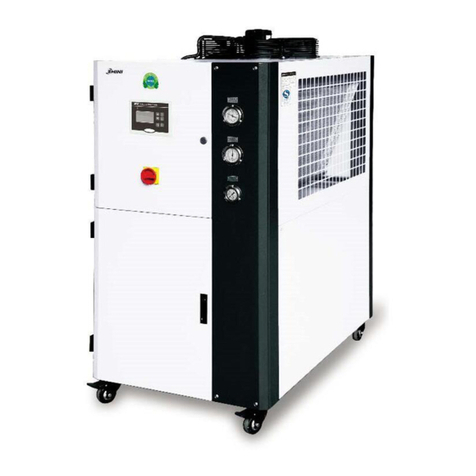
Shini
Shini SIC-A-R2 Operation manual

CLIVET
CLIVET WiSAN-YSE1 10.1 Service manual
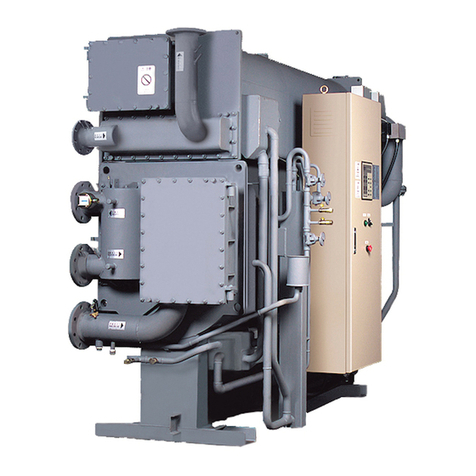
Sanyo
Sanyo Carrier 16LJ Series installation instructions
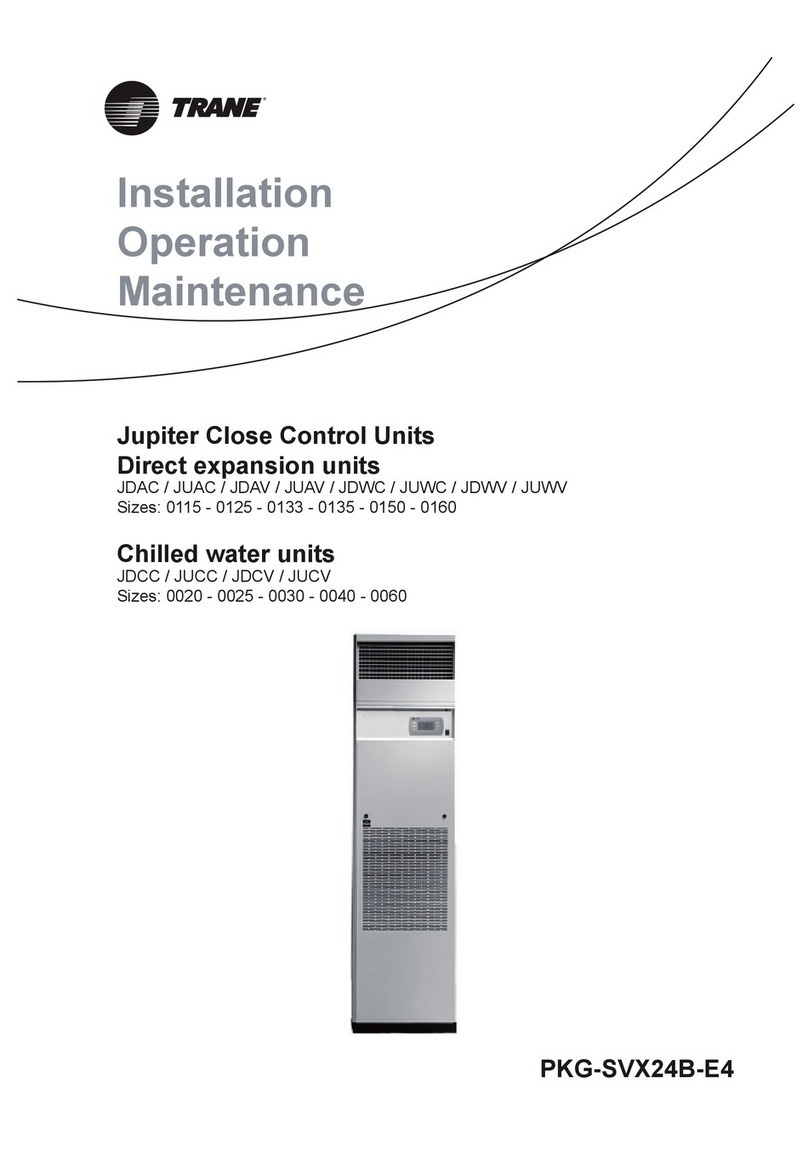
Trane
Trane Jupiter JDAC Series Installation operation & maintenance
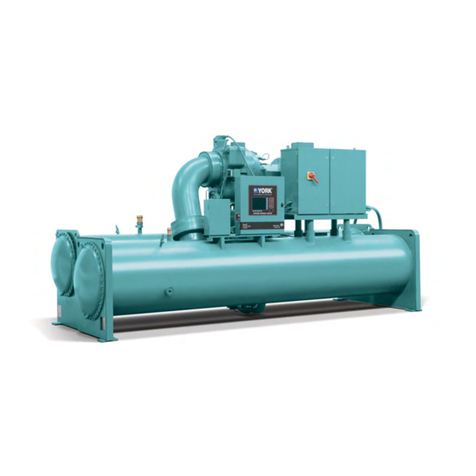
Johnson Controls
Johnson Controls York OptiView YK G Series Operation and maintenance
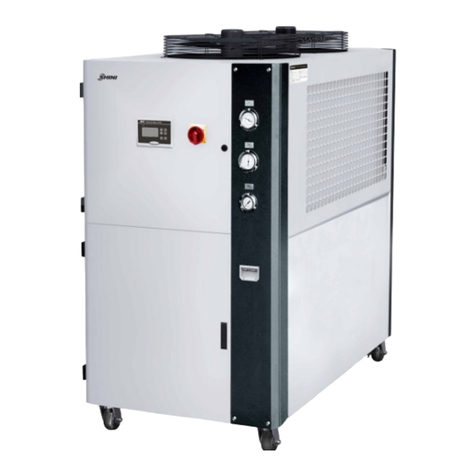
Shini
Shini SIC-A manual

Zanotti
Zanotti BX Use and maintenance instructions
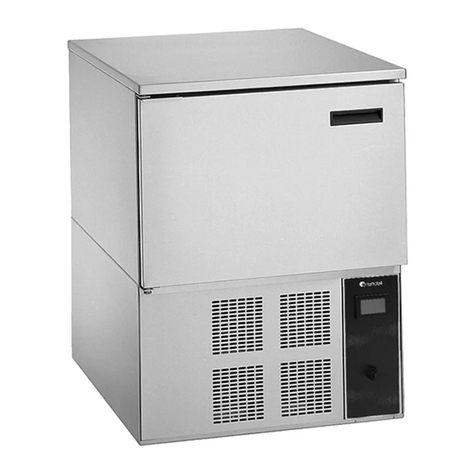
Randell
Randell BC-918RI Operator's manual
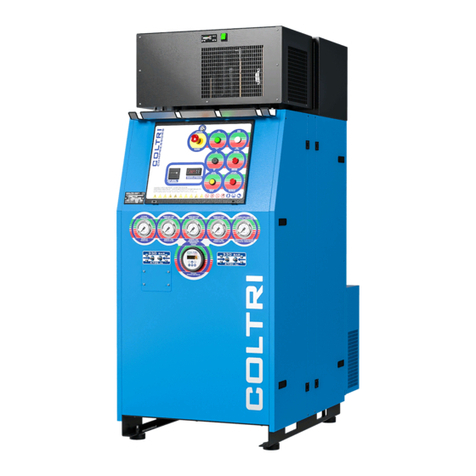
Coltri Compressors
Coltri Compressors Tornado Users maintenance and spare parts manual

CHILLY
CHILLY 45-M instruction manual
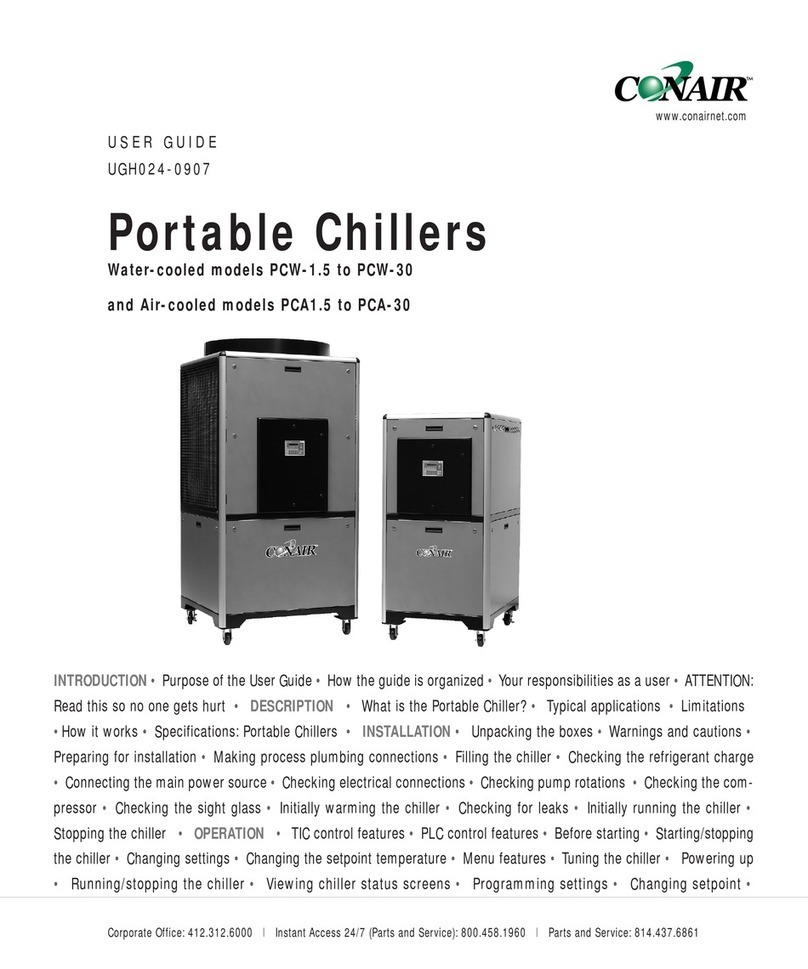
Conair
Conair PCW-1.5 user guide
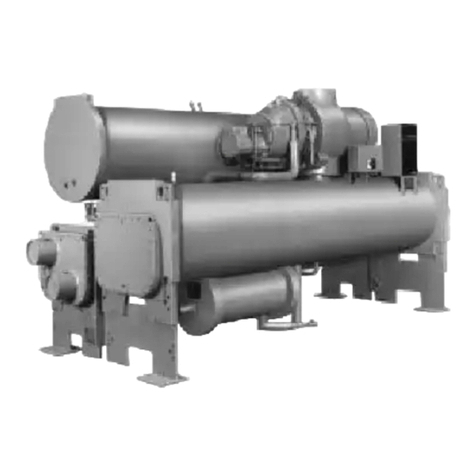
Carrier
Carrier 23XL Start-up, operation and maintenance instructions

